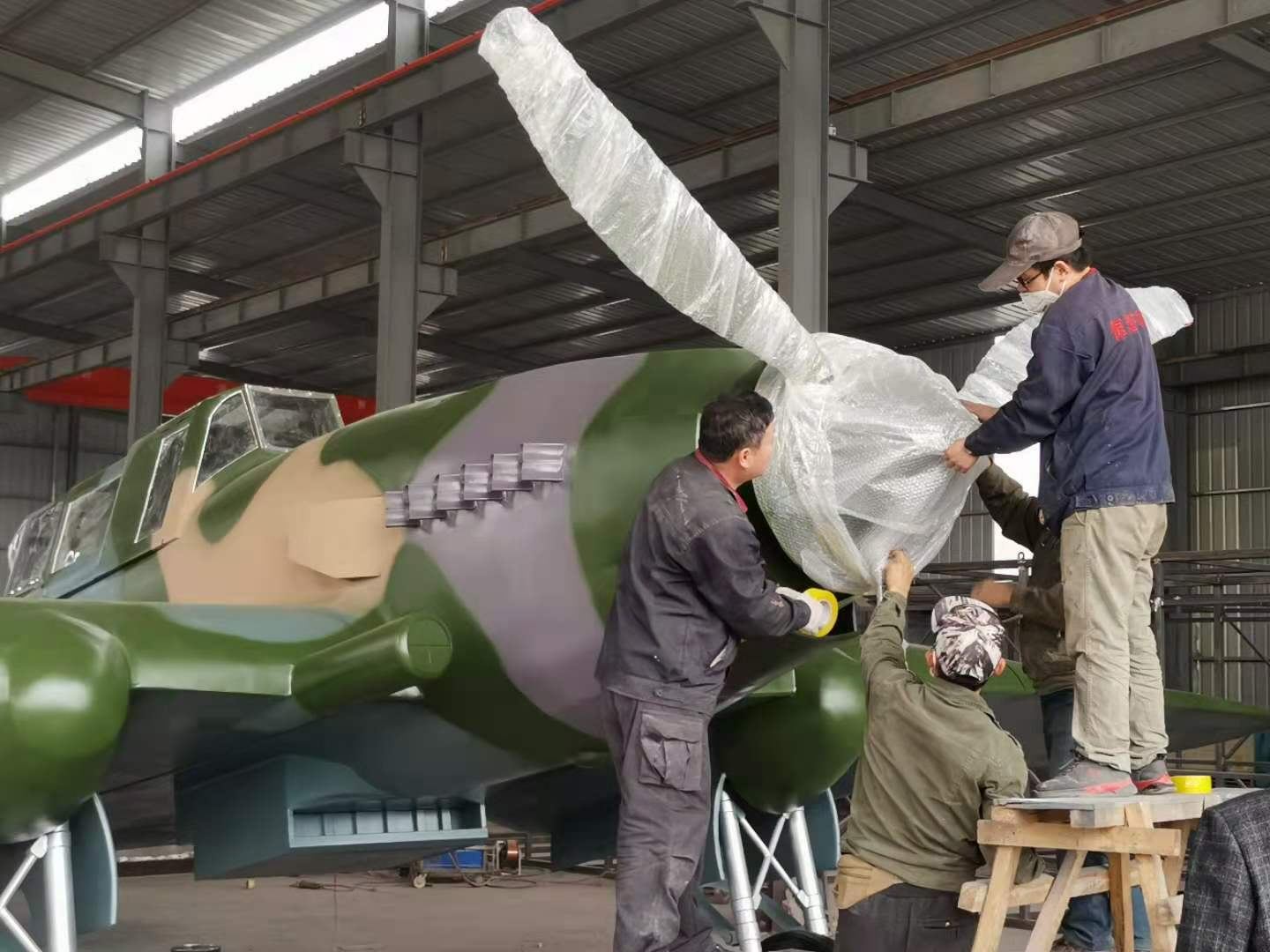服務(wù)熱線
李經(jīng)理13695310799服務(wù)熱線
李經(jīng)理13695310799大型航空模型:從設(shè)計到調(diào)試的制作流程
發(fā)布時間:2025-07-09 來源:http://ixuanli.com/
大型航空模型的制作是一項(xiàng)融合技術(shù)與耐心的工作,,需遵循嚴(yán)謹(jǐn)?shù)牧鞒桃源_保模型的性能。其制作過程大致可分為設(shè)計規(guī)劃,、材料選擇、部件制作,、組裝整合及調(diào)試優(yōu)化幾個關(guān)鍵階段,。
The production of large-scale aviation models is a fusion of technology and patience, requiring adherence to rigorous processes to ensure the performance of the models. The production process can be roughly divided into several key stages: design planning, material selection, component manufacturing, assembly integration, and debugging optimization.
設(shè)計規(guī)劃是制作的起點(diǎn),需先明確模型的尺寸,、比例及功能定位,。通常會參考真實(shí)航空器的氣動布局,結(jié)合模型的使用場景(如靜態(tài)展示或動態(tài)飛行),,通過繪圖軟件繪制詳細(xì)的三維圖紙,,確定機(jī)翼、機(jī)身,、尾翼等部件的結(jié)構(gòu)參數(shù),。對于動態(tài)模型,還需計算重心位置,、升力分布等數(shù)據(jù),,為后續(xù)的氣動性能奠定基礎(chǔ)。
Design planning is the starting point of production, and it is necessary to first clarify the dimensions, proportions, and functional positioning of the model. Usually, reference is made to the aerodynamic layout of real aircraft, combined with the usage scenarios of the model (such as static display or dynamic flight), and detailed 3D drawings are drawn through drawing software to determine the structural parameters of components such as wings, fuselage, and tail wing. For dynamic models, data such as center of gravity position and lift distribution need to be calculated to lay the foundation for subsequent aerodynamic performance.
材料選擇需兼顧強(qiáng)度,、重量與可塑性,。常用材料包括輕木、碳纖維板,、泡沫板及工程塑料等,。輕木質(zhì)地輕盈且易于加工,適合制作框架結(jié)構(gòu),;碳纖維板強(qiáng)度高,、剛性好,,多用于受力較大的部件如機(jī)翼主梁;泡沫板則因成本低,、易切割,,常作為填充或造型材料。選擇時需根據(jù)各部件的受力需求合理搭配,,在保證結(jié)構(gòu)穩(wěn)固的同時控制整體重量,。
The selection of materials should take into account strength, weight, and plasticity. Common materials include light wood, carbon fiber board, foam board and engineering plastics. Light wood is lightweight and easy to process, suitable for making frame structures; Carbon fiber board has high strength and good rigidity, and is often used for components with high stress, such as wing main beams; Foam board is often used as filling or molding material because of its low cost and easy cutting. When selecting, it is necessary to match the components reasonably according to their stress requirements, while ensuring structural stability and controlling overall weight.
部件制作需按圖紙分步進(jìn)行。機(jī)身通常采用框架拼接結(jié)構(gòu),,先將輕木條或碳纖維桿按尺寸裁切,,通過膠水拼接成骨架,再覆蓋蒙皮(如熱縮膜或薄木板)以形成流線型外觀,。機(jī)翼制作需注重弧度與對稱性,,可通過模具固定形狀,確保兩側(cè)機(jī)翼的幾何參數(shù)一致,;尾翼則需精準(zhǔn)控制面積與角度,,以保證模型的穩(wěn)定性。動態(tài)模型的動力系統(tǒng)部件(如電機(jī),、螺旋槳)需根據(jù)功率需求提前預(yù)留安裝位置,。
The production of components needs to be carried out step by step according to the drawings. The fuselage usually adopts a frame splicing structure, first cutting light wooden strips or carbon fiber rods according to size, splicing them into a skeleton through glue, and then covering the skin (such as heat shrink film or thin wooden board) to form a streamlined appearance. Wing production should pay attention to curvature and symmetry, and the shape can be fixed through molds to ensure that the geometric parameters of the wings on both sides are consistent; The tail wing requires precise control of area and angle to ensure the stability of the model. The power system components of dynamic models, such as motors and propellers, need to reserve installation positions in advance according to power requirements.
組裝整合是將各部件連接成整體的過程。先通過定位工具確保機(jī)翼與機(jī)身的安裝角度符合設(shè)計要求,,采用螺栓或高強(qiáng)度膠水固定,,同時預(yù)留檢修通道。尾翼與機(jī)身的連接需保證垂直與水平方向的精度,,避免因安裝偏差影響飛行平衡,。對于動態(tài)模型,還需安裝電池,、遙控器接收裝置等,,并梳理線路確保布局合理,避免干擾,。
Assembly and integration is the process of connecting various components into a whole. First, use positioning tools to ensure that the installation angle between the wing and the fuselage meets the design requirements, fix them with bolts or high-strength glue, and reserve maintenance channels. The connection between the tail wing and the fuselage needs to ensure vertical and horizontal accuracy to avoid affecting flight balance due to installation deviations. For dynamic models, it is necessary to install batteries, remote control receivers, etc., and organize the wiring to ensure a reasonable layout and avoid interference.
調(diào)試優(yōu)化是保障模型性能的關(guān)鍵,。靜態(tài)模型主要檢查外觀平整度與比例協(xié)調(diào)性,對瑕疵處進(jìn)行打磨修補(bǔ),。動態(tài)模型需先進(jìn)行地面測試,,檢查電機(jī)運(yùn)轉(zhuǎn)、舵機(jī)響應(yīng)是否正常,,調(diào)整重心位置至設(shè)計范圍。隨后進(jìn)行低空試飛,,觀察模型的爬升,、轉(zhuǎn)彎等動作是否平穩(wěn),,根據(jù)實(shí)際飛行狀態(tài)微調(diào)尾翼角度或配重,直至達(dá)到理想的操控效果,。
Debugging and optimization are key to ensuring model performance. The static model mainly checks the flatness and proportion coordination of the appearance, and grinds and repairs any defects. The dynamic model needs to undergo ground testing first to check whether the motor operation and servo response are normal, and adjust the center of gravity position to the design range. Subsequently, conduct a low altitude test flight to observe whether the model's climbing, turning, and other movements are smooth. Adjust the tail angle or weight according to the actual flight status until the desired control effect is achieved.
本文由大型航空模型制作友情奉獻(xiàn).更多有關(guān)的知識請點(diǎn)擊:http://ixuanli.com我們將會對您提出的疑問進(jìn)行詳細(xì)的解答,,歡迎您登錄網(wǎng)站留言.
This article is a friendly contribution from a large aircraft model For more information, please click: http://ixuanli.com We will provide detailed answers to your questions. You are welcome to log in to our website and leave a message
熱門產(chǎn)品 / HOT PRODUCT
新聞推薦 / NEWS RECOMMENDATIONS